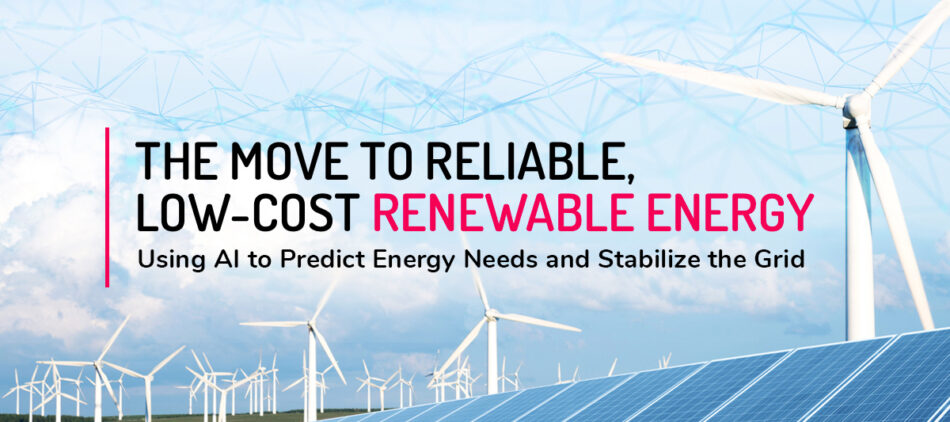
The Move to Reliable, Low-Cost Renewable Energy
Using AI to Predict Energy Needs and Stabilize the Grid
The Challenge
The US energy grid was originally designed around centralized power generation and regional distribution networks to provide safe, affordable, and reliable electricity to every American. And historically, it has performed this function very well. However, the energy grid of today suffers from a host of limitations:
- The grid itself is more than a century old, requiring a never-ending series of patches and upgrades to keep the underlying infrastructure intact
- Most utilities generate their power from fossil fuel, which introduces CO2 and other harmful toxins into the air and water
- Fossil fuel is also a finite resource that is becoming increasingly difficult to source and extract – a trend reflected in skyrocketing bills nationwide
- There are often real-time mismatches between energy supply and demand, with many utility providers having to underprice or even dump electricity that goes unused
The Quest for a Greener and More Modern Energy Grid
Because of the above factors, traditional energy generation is becoming more expensive for producers and consumers alike. The environment also pays a price when we power our communities with energy sources that pollute. And these growing concerns have prompted calls to quickly modernize the grid, with special emphasis on 4 key areas:
- Decarbonization – i.e. fading out fossil fuels in favor of solar and wind – 2 renewables that can be harnessed responsibly without putting the environment or human health at risk
- Decentralization – i.e. adding more redundancy to the grid via distributed power sources that move energy generation and storage closer to where it is consumed
- Democratization – i.e. end-users being able to generate their own power from rooftop solar without relying exclusively on conventional gatekeepers (like utility providers)
- Digitization – i.e. using emerging technologies like microgrids to better manage collective power sources as more capacity is added to America’s existing grid infrastructure
Why Isn’t America’s Electricity Grid Already Green?
The move to a more sustainable energy grid is already happening organically. However, this transition isn’t without its challenges. For example, adding more solar and wind capacity makes synchronizing voltage and frequency more difficult when trying to incorporate renewables into existing grid infrastructure. And far from making the electricity network more reliable, this patchwork can often result in more equipment failures, inconsistent energy delivery, and blackouts.
Decentralization and democratization have also proved problematic – making it harder to balance supply and demand against a backdrop of more moving parts (in more locations). In regions of the country that have seen rapid upticks in consumer solar, for example, utilities must increasingly scramble to manage daytime surges in PV production with sudden drop-offs in power generation once the sun goes down.
Using Artificial Intelligence to Make Smarter Energy Decisions
The energy challenges our country faces are very real. Fortunately, it’s possible to use artificial intelligence (AI) technology to help streamline the nation’s transition to more sustainable forms of electricity. Veritone Energy powered by aiWARE, for example, is a predictive energy solution that uses Hamiltonian data models, rules and machine learning to help utilities, independent operators, and other energy stakeholders overcome many of the challenges and limitations outlined above.
The next several articles in this series will explore the capabilities of the Veritone Energy solution:
- Forecaster accurately predicts weather, energy demand, and pricing in real time
- Optimizer uses those predictions to maximize performance based on supply and demand – both at the macro and micro levels – and synchronizes distributed energy resources with the grid
- Controller uses the optimized energy mix to optimize and synchronize power generation and distribution between devices across the network
- Arbitrage delivers real-time pricing data, which allows you to buy, sell, or dispatch energy whenever it is most profitable to do so
- Simulator runs forecasting models for long-term planning, investment, and resource allocation
Ready to Revolutionize your Energy Business?
Like almost every other aspect of society, America’s energy landscape is evolving at an unprecedented speed. And these rapid changes continue to introduce far too much data for any single person to manage. This is especially true given the growing popularity of renewable power sources and on-site storage. However, Veritone’s powerful AI solution overcomes these roadblocks:
- Optimizing and synchronizing renewables to deliver greenpower to communities with unparalleled efficiency
- Enhancing grid stability while moving the planet closer to its goal of ending fossil fuel dependence
- Enabling better-informed and real-time decisions – whether you’re trying to maximize profits, minimize waste, or prevent equipment damage
So be sure to follow the next several installments as we explore how Veritone’s suite of AI-powered tools can help you capitalize on the country’s changing energy landscape.
Learn more about what we’re doing to accelerate the transition to more sustainable, reliable and affordable energy, or contact us to discuss how Veritone’s dynamic, predictive energy solution can revolutionize your business.
Further Reading
Webinar Replay: Using Predictive AI to Optimize the Grid
Veritone Brings Efficiency and Optimization to Smart Grids with Real-Time Predictive AI
Will Occasional Blackouts Become the Norm?
North America Smart Energy Week/Solar Power International 2020 Virtual Conference
Can AI-Powered Energy Forecasting & Optimization Software Save America’s Power Grid?